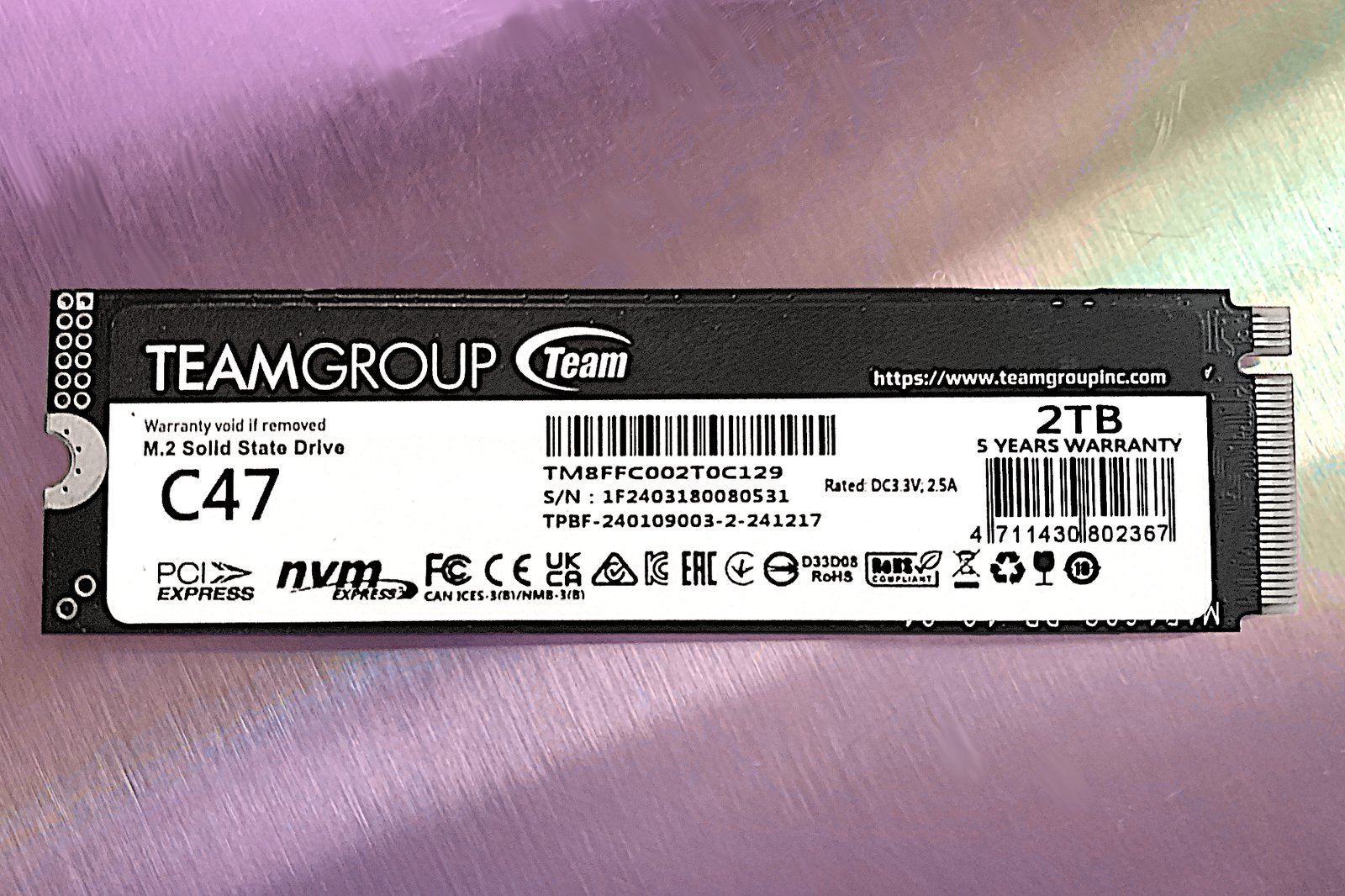At a glance
Expert’s Rating
Pros
- Decent HMB PCIe 4.0 performance
- Sustains long write performance better than most of the budget competition
- Extremely generous TBW ratings
Cons
- Slower overall than much of the HMB PCIe 4.0 competition
- Pricier than the performance at launch
Our Verdict
The Teamgroup C47 fell a bit shy of the competition in synthetic benchmarks, but was their equal in our real-world 48GB transfer tests and better than most during large sustained writes.
Price When Reviewed
This value will show the geolocated pricing text for product undefined
Best Pricing Today
Best Prices Today: Teamgroup C47 NVMe SSD
PCIe 4.0 HMB NVMe SSDs have flooded our test portals recently. And while I’d like to say unequivocally that the Teamgroup T-Create C47 is among the best of them, it tested below par in synthetic benchmarks and our 450GB write.
That said, it does sustain long writes exceptionally well, and also finished second among PCIe 4.0 HMB drives in our 48GB transfer tests. At the right price (cheaper than it was at the time of this writing), it’s worthy of your short list.
Read on to learn more, then see our roundup of the best SSDs for comparison.
What are the Teamgroup T-Create C47’s features?
The T-Create C47 is a 2280 (22mm wide, 80mm long) M.2, PCIe 4.0 x4 NVMe SSD that employs a Maxio MAP1602A-F3C controller and 232-layer TLC NAND. It’s a host memory buffer design that uses a portion of your PC’s memory as primary cache.
Secondary caching, as with all NVMe SSDs (DRAM or HMB), is done by writing a certain portion of the NAND as SLC (Single-Layer/1-bit) then transferring it at the native bit-depth in the background as time allows.
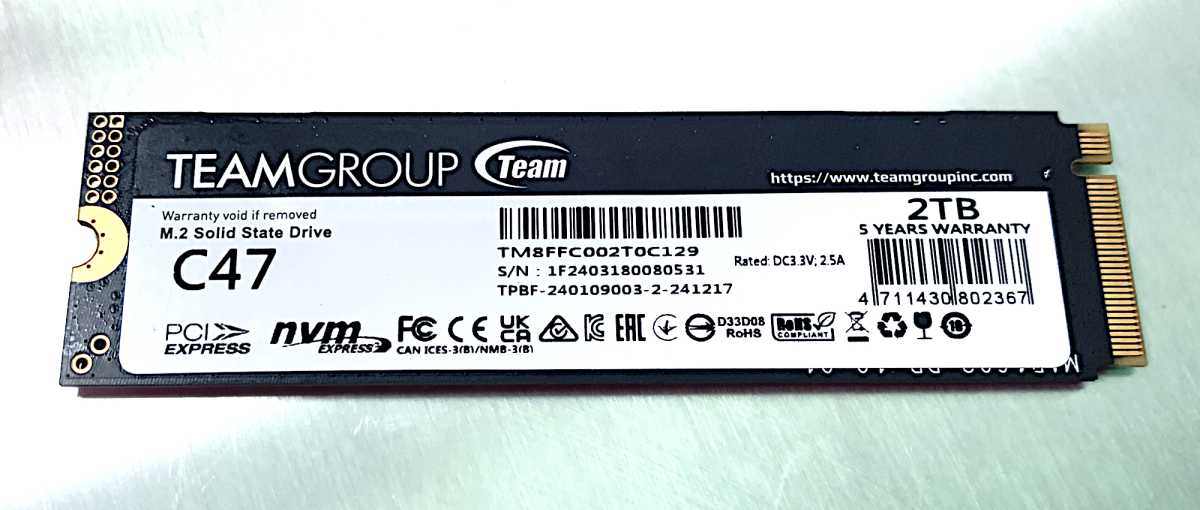
Writing a single bit per cell obviates the need for extensive error checking to see if a multi-bit cell was written at the proper voltage. It’s the voltage level in a multi-level cell that determines its numeric value. SLC is either charged or not — i.e., on or off.
The T-Create C47 carries a variable, but still quite generous TBW (terabytes that may be written before read-only mode) rating of 500TBW for the 512GB model, 1,000TBW for the 1TB capacity, 1,500TBW for the 2TB version, and 3,000TBW for the 4TB capacity. The norm for TLC is only 600TBW per TB of capacity. Teamgroup also warranties the drive for five years.
How much is the Teamgroup C47?
At the time of this writing the 1TB T-Create was $75 on Amazon, and the 2TB version I tested was $120. The 512MB and 4TB capacities were unavailable at the time of this writing.
Compared to its peers, $75 is a little high for a 1TB, but $120 is spot on for a 2TB PCIe 4.0 HMB SSD at the moment — there’s not a stupendous variation in price between brands at this point in time in this class.
How fast is the Teamgroup T-Create C47?
The C47 will get the job done, just perhaps not as quickly as other PCIe 4.0 host memory buffer SSDs. Overall, it’s fine, even in the real world, but there are a couple of eye-opening dips in the synthetic results.

The most puzzling result for the C47 was its 32-queue random write score. HMB SSDs are generally great at this. Both the competing WD SN5100 and the Lexar Play 2280 are PCIe 4.0 HMB designs, and were considerably faster in this test. On the other hand, reading was around average. Go figure.
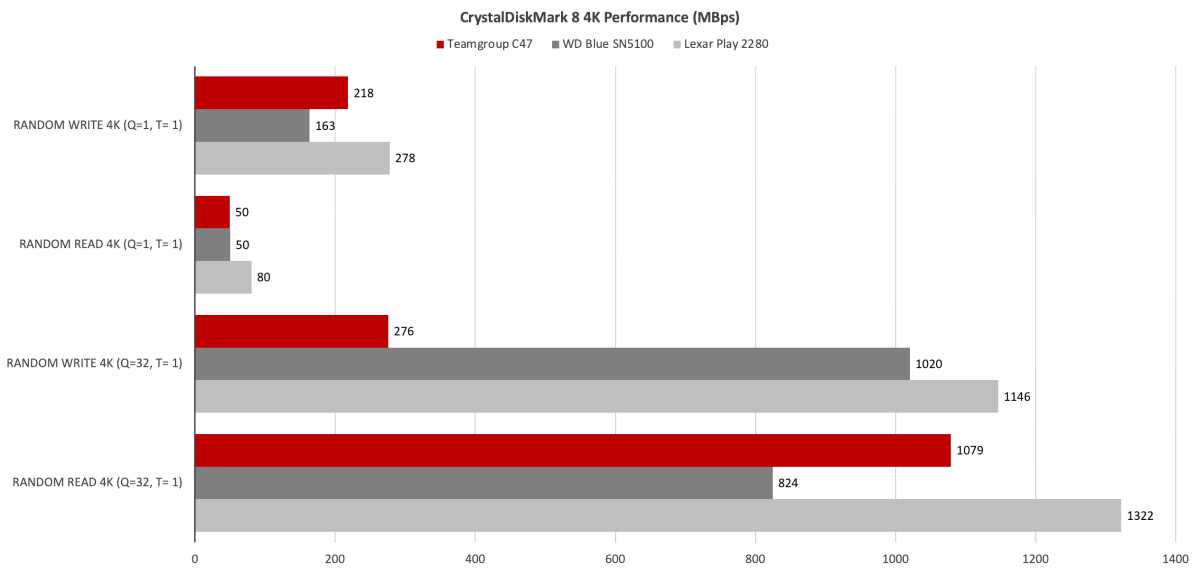
While it wasn’t aces in our synthetic benchmark tests, the C47 fared quite well in our real-world transfer tests. Note that FastCopy shows the real potential of the SSD. I still include Windows Explorer results as those are what users will encounter most often, but I highly recommend that you download that more-than-worthy utility for large file transfers. It’s free for private use.
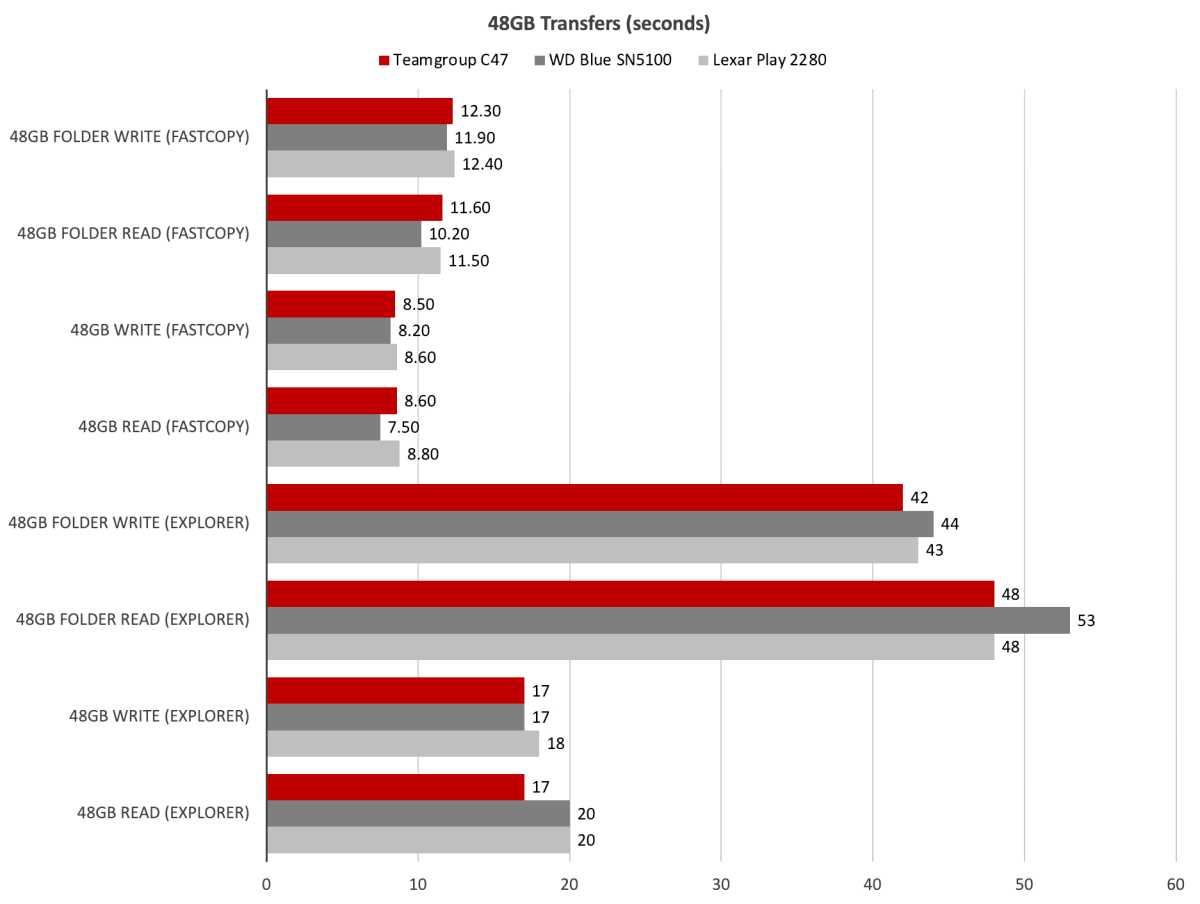
Again, the C47 was off the pace writing our 450GB test file. Not horribly, but noticeably so. But that news isn’t nearly so bad as it appears…
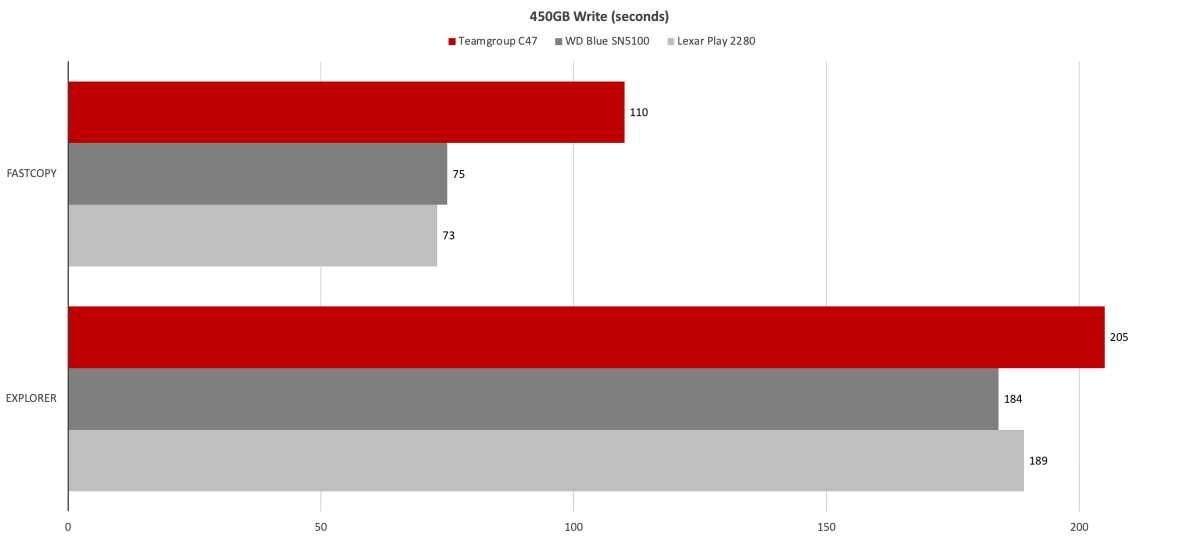
…because, while the performance above might not indicate such, the C47 is actually one of the best budget SSDs I’ve tested for writing large amounts of contiguous data. How so?
The 2TB drive I tested didn’t slow down appreciably (2.45GBps to 195GBps) during a 950GB write — most drives in this class do.
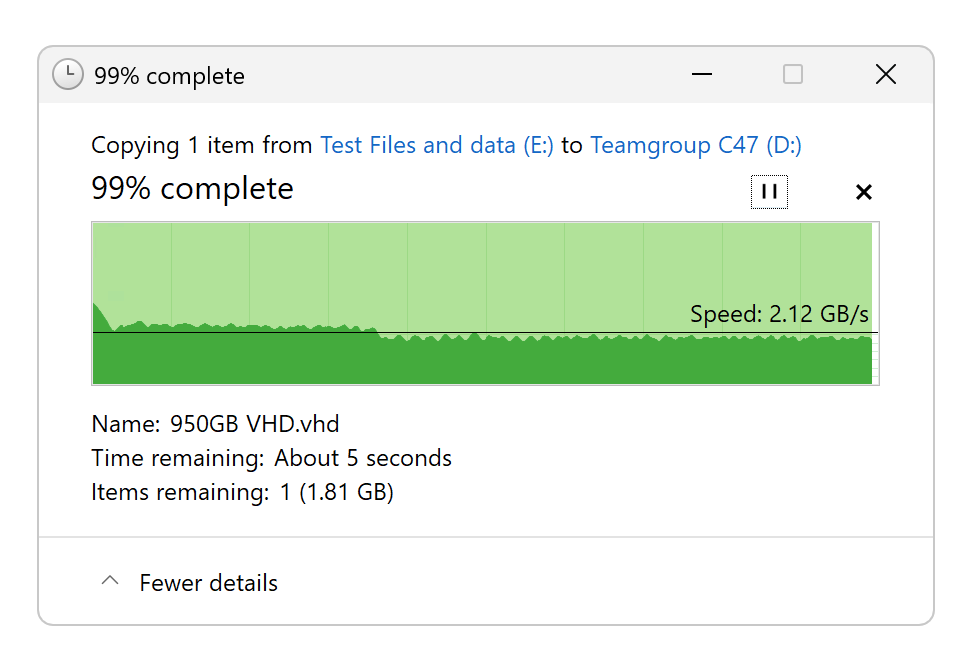
In fact, it took an additional 450GB write before the write rate dropped to 500MBps to 800MBps at around the 160GB mark. It stayed there for the remainder of the write. I’ve seen far worse native write rates (writing at the full bit-depth of the NAND) in the past. This is on par with a SATA SSD where once TLC/QLC native writes were slower than a hard drive. Ah, progress!
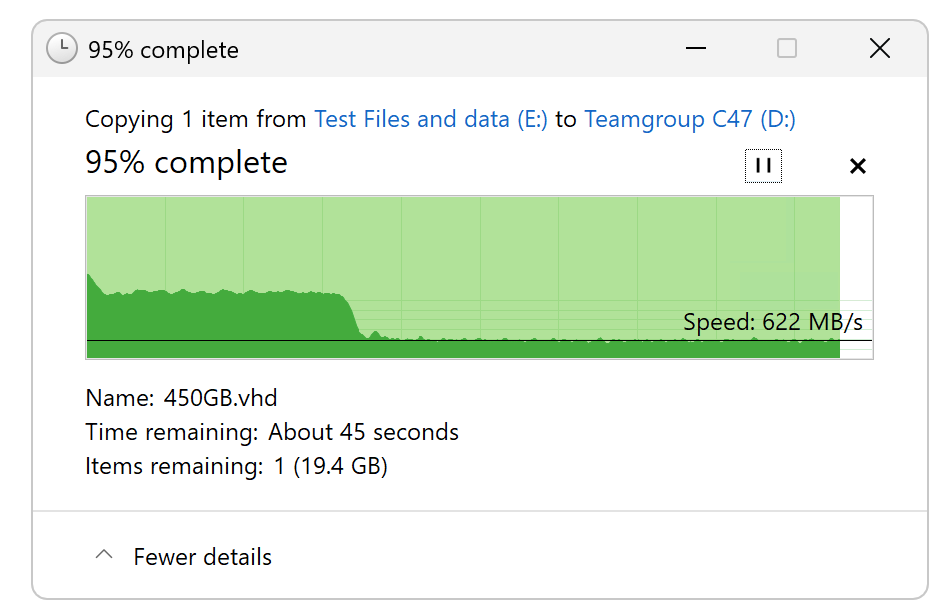
Okay, so the C47 didn’t take home the blue ribbon in any test except a non-chart result. Not tanking completely during long writes carries a lot of weight in our evaluation. Where the C47 is slow — with queued random reads and writes — doesn’t matter so much as not a lot of software, including Windows, doesn’t really use queues. Sadly.
Should you buy the Teamgroup T-Create C47?
While the C47 is one of the slower PCIe 4.0 host memory buffer drives in synthetic benchmarks that I’ve tested, I was definitely impressed by its sustained native write rate.
Regardless, price is the prime determinator in late-model PCIe 4.0 HMB SSDs. If it’s cheaper than the competition, go for it. You’ll never notice the difference subjectively. If it’s not cheaper, go with something else such as the WD Black SN7100/Blue 5100 or Lexar Play 2280.
Note: There’s no relation to the famous C-47 cargo plane that I’m aware of, other than hauling the freight.
How we test
Drive tests currently utilize Windows 11 24H2, 64-bit running off of a PCIe 4.0 Samsung 990 Pro in an Asus Z890-Creator WiFi (PCIe 4.0/5.0) motherboard. The CPU is a Core Ultra i5 225 feeding/fed by two Kingston Fury 32GB DDR5 4800MHz modules (64GB of memory total). Both 20Gbps USB and Thunderbolt 5 are integrated and Intel CPU/GPU graphics are used. PCIe 5.0 SSDs involved in testing are mounted in a Asus ROG PCIe 5.0 M.2 adapter card and a HighPoint 7604A 16x PCIe 5.0 4-port M.2 adapter card.
We run the CrystalDiskMark 8 (and 9), AS SSD 2, and ATTO 4 synthetic benchmarks (to keep article length down, we only report one) to find the storage device’s potential performance, then a series of 48GB and 450GB transfers tests using Windows Explorer drag and drop to show what you’ll see under Window, as well as the far faster Xcopy and FastCopy to show what’s possible.
A 25GBps two-SSD RAID 0 array on the aforementioned Highpoint 7604A is used as the second drive in our transfer tests. Formerly the 48GB tests were done with a RAM disk.
Each test is performed on a NTFS-formatted and newly TRIM’d drive so the results are optimal. Note that in normal use, as a drive fills up, performance may decrease due to less NAND for secondary caching, as well as other factors. This issue has abated somewher with the current crop of SSDs with more mature controllers and far faster late-generation NAND.
Caveat: The performance numbers shown apply only to the drive we were shipped and to the capacity tested. SSD performance can and will vary by capacity due to more or fewer chips to shotgun reads/writes across and the amount of NAND available for secondary caching. Vendors also occasionally swap components. If you ever notice a large discrepancy between the performance you experience and that which we report, by all means, let us know.
This articles is written by : Nermeen Nabil Khear Abdelmalak
All rights reserved to : USAGOLDMIES . www.usagoldmines.com
You can Enjoy surfing our website categories and read more content in many fields you may like .
Why USAGoldMines ?
USAGoldMines is a comprehensive website offering the latest in financial, crypto, and technical news. With specialized sections for each category, it provides readers with up-to-date market insights, investment trends, and technological advancements, making it a valuable resource for investors and enthusiasts in the fast-paced financial world.
